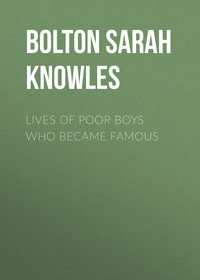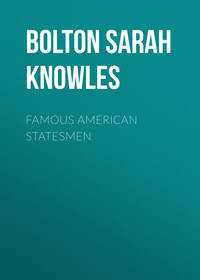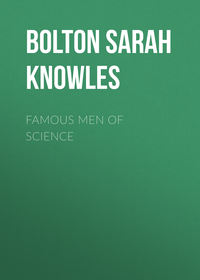 полная версия
полная версияFamous Givers and Their Gifts
Once when Mr. Shaw was escorting a lady through his gardens, she said, "I cannot understand, sir, how you are able to remember all these different and difficult names." – "Madam," he replied, with a courtly bow, "did you ever know a mother who could forget the names of her children? These plants and flowers are my children. How can I forget them?"
So devoted was Mr. Shaw to his work, that he did not go out of St. Louis for nearly twenty years, except for a drive to the neighboring village of Kirkwood to dine with a friend.
Nine years after the garden had been established, in 1866, Mr. Shaw began to create Tower Grove Park, of two hundred and seventy-six acres, planting from year to year over twenty thousand trees, all raised in the arboretum of the garden. Walks were gravelled, flower-beds laid out, ornamental water provided, and artistic statues of heroic size, made by Baron von Mueller of Munich, of Shakespeare, Humboldt, and Columbus. The niece of Humboldt, who saw the statue of her uncle at Munich, wrote to Mr. Shaw, saying that "Europe had done nothing comparable to it for the great naturalist."
Mr. Shaw used to say, when setting out these trees, that he was "planting them for posterity," as he did not expect to live to see them reach maturity. They were, however, of good size when he died in his ninetieth year, Sunday, Aug. 25, 1889.
"The death, peaceful and painless," says Mr. Dimmock, "occurred in his favorite room on the second floor of the old homestead, by the window of which he sat nearly every night for more than thirty years until the morning hours, absorbed in the reading which had been the delight of his life. This room was always plainly furnished, containing only a brass bedstead, tables, chairs, and the few books he loved to have near him. The windows looked out upon the old garden which was the first botanical beginning at Tower Grove.
"On Saturday, Aug. 31, after such ceremonial as St. Louis never before bestowed upon any deceased citizen, Henry Shaw was laid to rest in the mausoleum long prepared in the midst of the garden he had created – not for himself merely, but for the generations that shall come after him, and who, enjoying it, will 'rise up and call him blessed.'"
Mr. Shaw was beloved by his workmen for his uniform kindness to them. Once when a young boy who was visiting him, and walking with him in the garden, passed a lame workman, and did not speak, although Mr. Shaw said "Good-morning, Henry," the courteous old gentleman said, "Charles, you did not speak to Henry. Go back and say 'Good-morning' to him." Mr. Shaw employed many Bohemians, because he said, "They do not seem to be very popular with us, and I think I ought to help them all I can."
Mr. Shaw was always simple in his tastes and economical in his habits. He drove his one-horse barouche till his friends, owing to his infirmities from increasing age, prevailed upon him to have a carriage and a driver.
Four years before the death of Mr. Shaw he endowed a School of Botany as a department of Washington University, giving improved real estate yielding over $5,000 annually. He desired "to promote education and investigation in that science, and in its application to horticulture, arboriculture, medicine, and the arts, and for the exemplification of the Divine wisdom and goodness as manifested throughout the vegetable kingdom."
Dr. Asa Gray had been deeply interested in this movement, and twice visited St. Louis to consult with Mr. Shaw. By the recommendation of Dr. Gray, Mr. William Trelease, Professor of Botany in Wisconsin University at Madison, a graduate of Cornell University, and associated for some time with Professor Gray in various labors, was made Englemann Professor in the Henry Shaw School of Botany.
Professor Trelease was also made director of the Missouri Botanical Garden, and has proved his fitness for the position by his high rank in scholarship, his contributions to literature, and his devotion to the work which Mr. Shaw felt satisfaction in committing to his care. His courtesy as well as ability have won him many friends. Mr. Shaw left by will various legacies to relatives and institutions, his property, invested largely in land, having become worth over a million dollars. He gave to hospitals, several orphan asylums, Old Ladies' Home, Girls' Industrial Home, Young Men's Christian Association, etc., but by far the larger part to his beloved garden. He wished it to be open every day of the week to the public, except on Sundays and holidays, the first Sunday in June and the first Sunday in September being exceptions to the rule. When the garden was opened the first Sunday of June, 1895, there were 20,159 visitors, and in September, though showery, 15,500.
Mr. Shaw bequeathed $1,000 annually for a banquet to the trustees of the garden, and literary and scientific men whom they choose to invite, thus to spread abroad the knowledge of the useful work the garden and schools of botany are doing; also $400 for a banquet to the gardeners of the institution, with the florists, nurserymen, and market-gardeners of St. Louis and vicinity. Each year $500 is to be used in premiums at flower-shows, and $200 for an annual sermon "on the wisdom and goodness of God as shown in the growth of flowers, fruits, and other products of the vegetable kingdom."
The Missouri Botanical Garden, Shaw's Garden as it is more commonly called, covering about forty-five acres, is situated on Tower Grove Avenue, about three miles southwest of the New Union Station. The former city residence of Mr. Shaw has been removed to the garden, in which are the herbarium and library, with 12,000 volumes. The herbarium contains the large collection of the late Dr. George Engelmann, about 100,000 specimens of pressed plants; and the general collection contains even more than this number of specimens from all parts of the world. The palms, the cacti, the tree-ferns, the fig-trees, etc., are of much interest. There is an observatory in the centre of the garden; and south of this, in a grove of shingle-oaks and sassafras-trees, is the mausoleum of Henry Shaw, containing a life-like reclining marble statue of the founder of the garden, with a full-blown rose in his hand.
During the past year several ponds have been made in the garden for the Victoria Regia, or Amazon water-lily, and other lilies. On the approach of winter, over a thousand plants are taken from the ground, potted, and distributed to charitable institutions and poor homes in the city.
Much practical good has resulted from the great gift of Henry Shaw. According to his will, there are six scholarships provided for garden pupils. Three hundred dollars a year are given to each, with tuition free, and lodging in a comfortable house adjacent to the garden. So many persons have applied for instruction, that as many are received as can be taught conveniently, each paying $25 yearly tuition fee.
The culture of flowers, small fruits, orchards, house-plants, etc., is taught; also landscape-gardening, drainage, surveying, and kindred subjects. "It is safe to predict," says the Hon. Wm. T. Harris, Commissioner of Education, "that the future will see a large representation of specialists resorting to St. Louis to pursue the studies necessary for the promotion of agricultural industry."
Dr. Trelease gives two courses of evening lectures at Washington University each year, and at the garden he gives practical help to his learners. He investigates plant diseases and the remedies, and aids the fruit-grower, the florist, and the farmer, in the best methods with grasses, seeds, trees, etc. He deprecates the reckless manner in which troublesome weeds are scattered from farm to farm with clover and grass seed. He and his assistants are making researches concerning plants, flowers, etc., which are published annually.
The memory of Henry Shaw, "the first great patron of botanical science in America," is held in honor and esteem by the scientific world. The flowers and trees which he loved and found pleasure in cultivating, each year make thousands happier.
Nature was to him a great teacher. In his garden, over a statue of "Victory," these words are engraved in stone: "O Lord, how manifold are thy works: in wisdom hast thou made them all."
The seasons will come and go; the flowers will bud and blossom year after year, and the trees spread out their branches: they will be a continual reminder of the white-haired man who planted them for the sake of doing good to others.
Harvard College received a valuable gift May, 1861, through the munificence of the late Benjamin Bussey of Roxbury, Mass., in property estimated at $413,092.80, "for a course of instruction in practical agriculture, and the various arts subservient thereto." The superb estate is near Jamaica Plain. The students of the Bussey Institute generally intend to become gardeners, florists, landscape-gardeners, and farmers. The Arnold Arboretum occupies a portion of the Bussey farm in West Roxbury. The fund given by the late James Arnold of New Bedford, Mass., for this purpose now amounts to $156,767.97.
JAMES SMITHSON
AND THE SMITHSONIAN INSTITUTION
Another Englishman besides Henry Shaw to whom America is much indebted is James Smithson, the giver of the Smithsonian Institution at Washington. Born in 1765 in France, he was the natural son of Hugh, third Duke of Northumberland, and Mrs. Elizabeth Macie, heiress of the Hungerfords of Audley, and niece of Charles, Duke of Somerset.
At Pembroke College, Oxford, he was devoted to science, especially chemistry, and spent his vacations in collecting minerals. He was graduated May 26, 1786, and thereafter gave his time to study and original research. In 1790 he was elected a Fellow of the Royal Society, and became the friend of many distinguished men, both in England and on the Continent, where he lived much of the time. Among his friends and correspondents, were Sir Humphry Davy, Berzelius (the noted chemist of Sweden), Gay-Lussac the chemist, Thomson, Wollaston, and others.
He wrote and published in the Philosophical Transactions of the Royal Society, and also in Thomson's Annals of Philosophy, many valuable papers on the "Composition of Zeolite," "On a Substance Procured from the Elm Tree, called Ulmine," "On a Saline Substance from Mount Vesuvius," "On Facts Relating to the Coloring Matter of Vegetables," etc. At his death he left about two hundred manuscripts. He was deeply interested in geology, and made copious notes in his journal on rocks and mining. His life seems to have been a quiet one, devoted to intellectual pursuits.
Professor Henry Carrington Bolton, in the Popular Science Monthly for January and February, 1896, relates this incident of Smithson: "It is said that he frequently narrated an anecdote of himself which illustrated his remarkable skill in analyzing minute quantities of substances, an ability which rivalled that of Dr. Wollaston. Happening to observe a tear gliding down a lady's cheek, he endeavored to catch it on a crystal vessel. One-half the tear-drop escaped; but he subjected the other half to reagents, and detected what was then called microcosmic salt, muriate of soda, and some other saline constituents held in solution."
When Mr. Smithson was over fifty years of age, in 1818 or 1819, he had a misunderstanding with the Royal Society, owing to their refusal to publish one of his papers. It is said that prior to this he intended to leave all his wealth, over $500,000 to the society.
About three years before his death, he made a brief will, giving the income of his fortune to his nephew, Henry James Hungerford, and the whole fortune to the children of his nephew, if he should marry. In case he did not marry, Smithson bequeathed the whole of his property "to the United States of America, to found at Washington, under the name of the Smithsonian Institution, an establishment for the increase and diffusion of knowledge among men."
Mr. Smithson, says Professor Simon Newcomb, "is not known to have had the personal acquaintance of an American, and his tastes were supposed to have been aristocratic rather than democratic. We thus have the curious spectacle of a retired English gentleman bequeathing the whole of his large fortune to our Government, to found an establishment which was described in ten words, without a memorandum of any kind by which his intentions could be divined, or the recipient of the gift guided in applying it."
Mr. Smithson died June 27, 1829, in Genoa, Italy, at the age of sixty-four. His nephew survived him only six years, dying unmarried at Pisa, Italy, June 5, 1835. He used the income from his uncle's estate while he lived, and upon his death it passed to the United States. Hungerford's mother, who had married a Frenchman, Madame Théodore de la Batut, claimed a life-interest in the estate of Smithson, which was granted till her death in 1861. To meet this annuity $26,210 was retained in England until she died.
For several years it was difficult to decide in what way Congress should use the money "for the increase and diffusion of knowledge among men." John Quincy Adams desired a great astronomical observatory; Rufus Choate of Massachusetts urged a grand library; a senator from Ohio wished a botanical garden; another person a college for women; another a school for indigent children of the District of Columbia; still another a great agricultural school.
After seven years of indecision and discussion the Smithsonian Institution was organized by act of Congress, Aug. 10, 1846, which provided for a suitable building to contain objects of natural history, a chemical laboratory, a library, gallery of art, and geological and mineralogical collections. The minerals, books, and other property of James Smithson, were to be preserved in the Institution.
Professor Joseph Henry, whose interesting life I have sketched in my "Famous Men of Science," was called to the headship of the new Institution. For thirty-three years he devoted his life to make Smithson's gift a blessing to the world and an honor to the name of the generous giver. The present secretary is the well-known Professor Samuel P. Langley.
The library was after a time transferred to the Library of Congress, the art department to the Corcoran Art Gallery, and the Smithsonian Institution began to do its specific work of helping men to make original scientific research, to aid in explorations, and to send scientific publications all over the world. Its first publication was a work on the mounds and earthworks found in the Mississippi Valley. Much time has also been given to the study of the character and pursuits of the earliest races on this continent.
The Smithsonian Institution now owns two large buildings, one completed in 1855, costing about $314,000, and the great National Museum, which Congress helped to build. This building has a floor space of 100,000 square feet, and contains over three and one-half million specimens of birds, fishes, Oriental antiquities, minerals, fossils, etc. So much of value has been gathered by government surveys, as well as by contributions from other nations by way of exchange, that halls twice as large as those now built could be filled by the specimens. So popular is the museum as a place to visit, that in the year ending June 30, 1893, over 300,000 persons enjoyed its interesting accumulations.
Correspondence is carried on with learned societies and men of science all over the world. The official list of correspondents is over 24,000. The transactions of learned societies and some other scientific works are exchanged with those abroad. The weight of matter sent abroad by the Smithsonian Institution at the end of the first decade was 14,000 pounds for 1857; at the end of the third decade 99,000 pounds for the year 1877. The official documents of Congress, or by the government bureaus, are exchanged for similar works of foreign nations. In one year, 1892-1893, over 100 tons of books were handled.
The "Smithsonian Contributions to Knowledge" now number over thirty volumes, and are valuable treatises on various branches of science. The scholarly William B. Taylor said these books "distributed over every portion of the civilized or colonized world constitute a monument to the memory of the founder, James Smithson, such as never before was builded on the foundation of £100,000."
The Smithsonian Institution has been a blessing in many ways. It organized a system of telegraphic meteorology, and gave to the world "that most beneficent national application of modern sciences, – the storm warnings."
In the year 1891 the Institution received valuable aid from Mr. Thomas G. Hodgkins of Setauket, N.Y., by the gift of $200,000. The income from $100,000 is to be used in prizes for essays relating to atmospheric air. Mr. Hodgkins, also an Englishman, died Nov. 25, 1892, nearly ninety years old. He gave $100,000 to the Royal Institution of Great Britain, and $50,000 each to the Society for Prevention of Cruelty to Children, and to Animals. He made his fortune, and having no family, spent it for "the diffusion of knowledge among men."
A very interesting feature was added to the work of the Smithsonian Institution in 1890, when Congress appropriated $200,000 for the purchase of land for the National Zoölogical Park. As no native wild animals in America seem safe from the cupidity of the trader, or the slaughter of the pleasure-loving sportsman, it became necessary to take measures for their preservation. About 170 acres were purchased on Rock Creek, near Washington; and there are already more than 500 animals – bisons, etc. – in these picturesque grounds. These will be valuable object-lessons to the people, and help still further to carry out James Smithson's idea, "the increase and diffusion of knowledge among men."
PRATT, LENOX, MARY MACRAE STUART, NEWBERRY, CRERAR, ASTOR, REYNOLDS,
AND THEIR LIBRARIES
ENOCH PRATT
Enoch Pratt was born in North Middleborough, Mass., Sept. 10, 1808. He graduated at Bridgewater Academy when he was fifteen; and a position was found for him in a leading house in Boston, where he remained until he was twenty-one years of age. He had written to a friend in Boston two weeks before his school closed, "I do not want to stay at home long after it is out."
The eager, ambitious boy, with good habits, constant application to business, the strictest honesty, and good common-sense, soon made himself respected by his employers and his acquaintances.
He removed to Baltimore in 1831, when he was twenty-three years old, without a dollar at his command, and established himself as a commission merchant. He founded the wholesale iron house of Pratt & Keith, and subsequently that of Enoch Pratt & Brother. "Prosperity soon followed," says the Hon. George Wm. Brown, "not rapidly but steadily, because it was based on those qualities of honesty, industry, sagacity, and energy, which, mingled with thrift, although they cannot be said to insure success, are certainly most likely to achieve it."
Six years after coming to Baltimore, when he was twenty-nine years old, Mr. Pratt married Maria Louisa Hyde, Aug. 1, 1837. Her paternal ancestors were among the earliest settlers of Massachusetts; her maternal, a German family who settled in Baltimore over a century and a half ago.
As years went by, and the unobtrusive, energetic man came to middle life, he was sought to fill various positions of honor and trust in Baltimore. He was made director and president of a bank, which position he has held for over twoscore years, director and vice-president of railroads and steamboat lines, president of the House of Reformation at Cheltenham (for colored children), and of the Maryland School for the Deaf and Dumb at Frederick. He has also taken active interest in the Maryland Institute for the Promotion of the Mechanic Arts, and is treasurer of the Peabody Institute.
For years he has been one of the finance commissioners elected by the city council, without regard to his political belief, but on account of his ability as a financier, and his wisdom. He is an active member of the Unitarian Church.
For several years Mr. Pratt had thought about giving a free public library to the people of Baltimore. In 1882, when he was seventy-four, Mr. Pratt gave to the city $1,058,000 for the establishing of his library, the building to cost about $225,000, and the remainder, a little over $833,000, to be invested by the city, which obligated itself to pay $50,000 yearly forever for the maintenance of the free library. Mr. Pratt also provided for four branch libraries, which cost $50,000, located wisely in different parts of the city.
The main library was opened Jan. 4, 1886, with appropriate ceremonies. The Romanesque building of Baltimore County white marble is 82 feet frontage, with a depth of 140 feet. A tower 98 feet high rises in the centre of the front. The floor of the vestibule is in black and white marble, and the wainscoting of Tennessee and Vermont marbles, principally of a dove color. The reading-room in the second story is 75 feet long, 37 feet wide, and 25 feet high. The walls are frescoed in buff and pale green tints, the wainscoting is of marble, and the floor is inlaid with cherry, pine, and oak. The main building will hold 250,000 volumes.
The Romanesque branch libraries are 40 by 70 feet, one story in height, built of pressed brick laid with red mortar, with buff stone trimmings. The large reading-room in each is light and cheerful, and the book-room has shelving for 15,000 volumes.
The librarian's report shows that in nine years, ending with Jan. 1, 1895, over 4,000,000 books have been circulated among the people of Baltimore. Over a half-million books are circulated each year. The library possesses about 150,000 volumes. "The usefulness of the branch libraries cannot be stated in too strong terms," says the librarian, Mr. Bernard C. Steiner. Fifty-seven persons are employed in the library, – fourteen men and forty-three women.
Mr. Pratt is now eighty-eight years old, and has not ceased to do good works. In 1865 he founded the Pratt Free School at Middleborough, Mass., where he was born. Ex-Mayor James Hodges tells this incident of Mr. Pratt: "Some years ago he sold a farm in Virginia to a worthy but poor young man for $20,000. The purchaser had paid from time to time one-half the purchase money, when a series of bad seasons and failure of crops made it impossible to meet the subsequent payments. Mr. Pratt sent for him, and learned the facts.
"After expressing sympathy for the young man's misfortunes, and encouraging him to persevere and hope, he cancelled his note for the balance due, – $10,000, – and handed him a valid deed for the property. Astonished and overwhelmed by this princely liberality, the recipient uttered a few words, and retired from his benefactor's presence. Not until he had reached his Virginia home was he able to find words to express his gratitude."
The great gift of Enoch Pratt in his free library has stimulated like gifts all over the country; and in his lifetime he is enjoying the fruits of his generosity.
JAMES LENOX
The founder of Lenox Library on Seventy-second Street, overlooking Central Park, was born in New York City, Aug. 19, 1800, and died there Feb. 17, 1880. His father, Robert, was a wealthy Scotch merchant of New York, who left to his only son and seven daughters several million dollars.
Robert purchased from the corporation of New York a farm of thirty acres of land in Fourth and Fifth Avenues, near Seventy-second Street. For twelve acres on one side he gave $500, and for the rest on the other side, $10,700. He thought the land might "at no distant day be the site of a village," and left it to his son on condition that it be kept from sale for several years.
The son was educated at Princeton and Columbia Colleges, studied law, but, being devoted to literary matters, spent much time abroad in collecting valuable books and works of art. The only lady to whom he was ever attached, it is stated, refused him, and both remained single.
He was a quiet, retiring man, a member of the Presbyterian Church, and a most generous giver, though his benefactions were kept from publicity as much as possible. He once sent $7,000 to a lady for a deserving charity, and refused her second application because she had told of his former gift.
He built Lenox Library of Lockport limestone, and gave to it $735,000 in cash, and ten city lots of great value, on which the building stands. The collection of books, marbles, pictures, etc., which he gave is valued at a million dollars.






